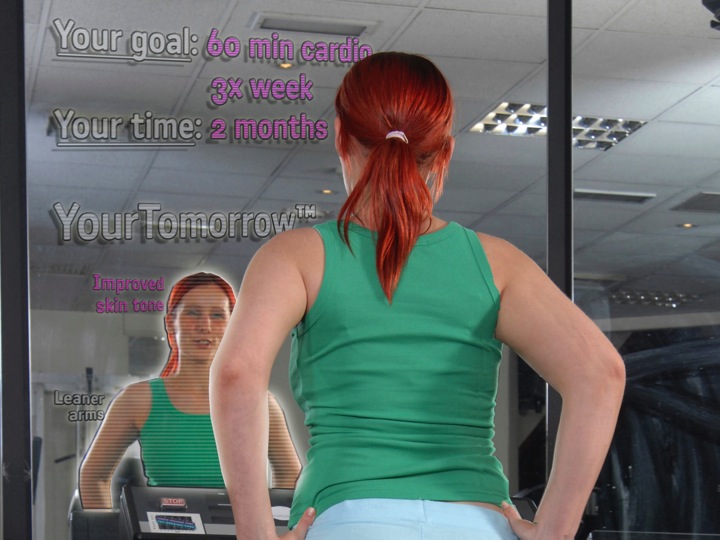Future Now
The IFTF Blog
Previewing Your Future Self
A few months ago, I highlighted a treadmill at Japanese gyms that flashes pictures of desserts at exercisers as they hit certain calorie counts in order to keep them motivated. Want that milkshake? Just run another half hour.
At the time, I was struck by its resemblance, at least in spirit, to my favorite artifact from the future from our recently released HC2020 Map. The artifact represents our forecast regarding health previews, which is the idea that advances in technologies and visualization techniques will enable us to preview the long-term effects of our immediate health choices on our bodies. It's pictured below:

I like this artifact because it's so immediately easy to grasp, but contains a deep layer of complexity. Who wouldn't be motivated to exercise a bit harder by a picture of a healthier, thinner, more attractive future you? The context of the gym here is critical too--we won't simply be able to get these sorts of motivations when we're too busy to look at them, but expect to begin to see these visualizations right when we need them to motivate us.
Of course, positive rewards--be they immediately tasty treats or long-term efforts at self-improvement--aren't the only things that motivate us. As my colleagues highlighted in the demonstration video below for our Body Shock the Future contest, visualization tools might also be used to show us the negative consequences of our actions--to, in effect, scare us into making healthier decisions.
In other words, these different visualizations--of immediate rewards, long-term rewards, or long-term consequences--highlight the range of possible ways that designers may experiment with persuading us in the future.
Hidden beneath these previews, though, is a second key point: In the future we'll have on-demand access to context-appropriate health information as well as increasingly powerful tools to develop increasingly personalized simulations.
For example, in 2008, science writer David Ewing Duncan wrote about his experiences using an experimental, computational health simulator developed by Entelos. In addition to traditional risk factors, the Entelos model took into account factors such as Duncan's personal genetics and other aspects of his biological identity. The risk assessment, as Duncan noted, was quite different:
In a Silicon Valley conference room I'm being told by a team of cutting-edge computer profilers that I have a 28 percent chance of having a heart attack by 2017, with my chances getting worse each year between now and then. By 2027, my risk jumps to 70 percent.
This compares with my internist's prognosis that my heart attack risk is a mere 4 percent in 10 years, a number he got during a routine checkup by matching up my cholesterol levels, age, and other factors to a scale considered state-of-the-art by most physicians.
As Duncan wrote in his book Experimental Man, the simulation was scary enough to convince him to lose about ten pounds--a choice that helped lower his heart attack risk.
In this sense, I think it's helpful to think about health previews developing along two key trajectories: Both in terms of our capacities to simulate particular effects on our bodies, as well as the ability to make those simulations increasingly persuasive, to make interacting with our future selves more personal to our real identities, as well as more compelling.



